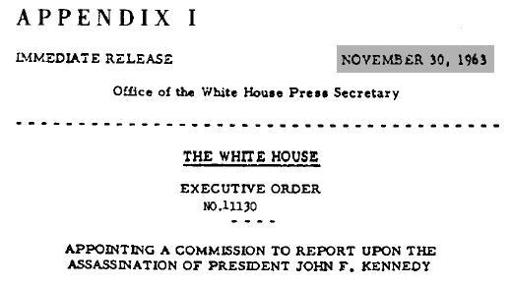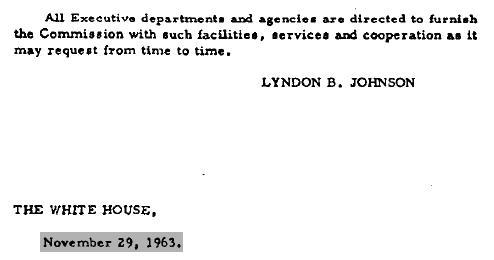Impossible: The Case Against Lee Harvey Oswald (53 page)
Read Impossible: The Case Against Lee Harvey Oswald Online
Authors: Barry Krusch
Tags: #Non-Fiction, #History
As far as I can tell, this is the hypothesis which has the most evidence behind it, so let me return to the original question which inspired this lengthy exploration of the possibilities, “Is there any way to show that commission witnesses had been coordinating their misstatements?”
With the evidence I have provided for the
false reporting
hypothesis, we now know that misstatements can be coordinated even if the person themselves did not make the statement, via the blue pencil technique. And, misstatements could obviously also be coordinated wherever there have been
rehearsals
designed to create this coordination.
Consequently, we can discover the presence of re-authoring or rehearsals by inference: synchronized testimony, whether through editorial control or rehearsal, is easy to show precisely where there are identical misstatements — we can immediately infer the presence of synchronized testimony when two people make exactly the same mistake concurrent in time. If A states that “29 + 29 = 100,” and B somewhat later states that “29 + 29 = 100,” we know that the probability that two individuals would make a mistake that improbable on their own would be extremely unlikely. The odds are, conversely, extremely high that if the blue pencil wasn’t used (and it most certainly could have been, as the Appendix demonstrated), the individuals in question pow-wowed beforehand and coordinated their statements (if indeed they made the statements), which sadly enough for them and their stories, are easily proven false, proving not only that each lied, but also that both agreed to tell the same lie . . .
Returning to the empty shells issue, let’s look at a very simple example of coordinated testimony between Captain Fritz, Detective Sims, and Lieutenant Day. We will start with Fritz, and an affidavit he prepared attempting to confirm the testimony by Day. The credibility of Fritz is already under fire because he made a statement contradicted by multiple witnesses in the Craig matter (discussed in the Appendix), and unfortunately for the validity of this affidavit, Day’s testimony reveals that this statement by Fritz must likewise be in error and also deficient in several respects. For example, in the following affidavit, Fritz states that
Sims
“brought the three empty hulls to my office.” (7 H 404)
Yet as we have already seen, the CSS form told us that it was
Brown
, not
Sims
, who received the empty shells from Day:
And, according to that form, it was
two
shells delivered to Brown, not
three
. Nor is there any testimony or document on record that Brown in turn delivered even these two shells to Sims.
An additional problem for the story that Sims received the shells is that if Sims had actually taken possession of them, he should have marked them (being the next recipient in the chain of custody). But if you will recall the testimony of Day, he nowhere indicates that Sims’ initials are on the shells, and, in fact, Sims himself would not state positively for the record that he initialed the shells, in yet another suspicious memory lapse all too reminiscent of the Day testimony;
I mean, if
you
were an experienced officer and were initialing empty shells that could have been used to murder your President, isn’t that something
you
would remember? Not Sims! (7 H 186):
69
We can be forgiven for seeing waffling like this as a pathetic attempt to avoid a charge of perjury. As you will recall, RMS was
not seen
on the shells (according to the testimony of Day, who had the benefit of a magnifying glass and a good light), and we can also see (upon review) that Sims’ name was
not
on the envelope (CE 717 at 17 H 501), as the testimony of Day likewise indicated (4 H 253):
70
So Sims’ professed “belief” (if in fact he
did
believe it) is as irrelevant as it is inaccurate.
So, here we have similar testimony by Day, Sims, and Fritz,
none
of it
corroborated
by hard documentary evidence, and
all
of it
contradicted
by that same evidence. Because they are all trying to tell the
same
story, a story not only
not backed up
by the necessary documents but
contradicted
by those documents, that’s a textbook example of synchronized misstatements. And a dozen or 100 or 1000 synchronized misstatements will not only never add up to the truth, but they have a paradoxical effect in the
other
direction: the more there are, the greater the proof that “the fix was in.”
There are other problems with the statement of Fritz: for example, we know from Day’s testimony that the envelope ostensibly delivered to Fritz (and ostensibly by Sims) was
unmarked
and
unsealed
, a key fact Fritz neglects to mention. Also, according to Day’s testimony of April 22, the envelope contained hulls that were not marked by Day at the scene, and so even if Sims actually
had
delivered an envelope to Fritz, we can’t be sure that that envelope contained the shells that were found at the Texas School Book Depository —
can
we? And even if this most likely imaginary envelope did contain
three
shells, we know from the analysis of Day’s testimony that it is absolutely certain that at least one of them was not fired from Lee Harvey Oswald’s rifle.
Apart from these issues, there is an additional misstatement by Fritz, which alone throws the entire affidavit into doubt. Re-read these three sentences from the Fritz statement (7 H 404):
Unfortunately for Captain Fritz’s story that he delivered the third hull on the night of November 27 to the FBI because “the Commission wanted the other empty hull,” that was
impossible
. The Executive Order forming the Warren Commission was issued
two days later
, November 29, as the following screen captures from the Warren Report reveal (WR 471):
71
While the date of the press release was November 30, the actual date of appointment was November 29, as we can see from the bottom line:
Other books
The Scourge of God by William Dietrich
Moonshine Murder [Hawkman Bk 14] by Betty Sullivan La Pierre
The Wolf of Harrow Hall (Tales of the Latter Kingdoms Book 7) by Christine Pope
Wrapping Up (Novella) Mitchell Family 4.5 (Wrapping Up Novella 4.5) by Foor, Jennifer
Chronicles of Aurderia: The Balance by J. Steven Young
The Blackham Mansion Haunting (The Downwinders Book 4) by Michael Richan
The Darkest Dream (The Darkest Trilogy) by Brewer, Michelle






